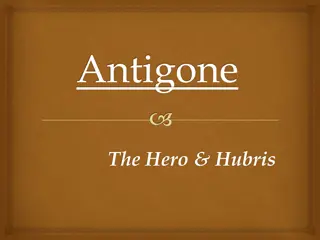Introduction to Greek Tragedy and Tragic Heroes
Explore the elements of Greek tragedy including the role of the chorus, the concept of fate, and the characteristics of a tragic hero like facing fate with strength. Discover iconic tragic heroes like Zorro, Anakin Skywalker, and Batman, examining qualities such as hubris and experiencing catharsis. Delve into the structure of Greek tragedies and the different parts like prologue, episodes, and exodos. Immerse yourself in the world of ancient Greek theatre and its significance.
Download Presentation

Please find below an Image/Link to download the presentation.
The content on the website is provided AS IS for your information and personal use only. It may not be sold, licensed, or shared on other websites without obtaining consent from the author. Download presentation by click this link. If you encounter any issues during the download, it is possible that the publisher has removed the file from their server.
E N D
Presentation Transcript
Chorus A masked group of actors who intermittently appear on stage to comment on the plot usually through song. Choragus = chorus leader
Fate Meaning 1: Preordained destiny Meaning 2: The Fates, or Moirai, are the three goddesses of fate (particularly death and pain).
Tragic Hero Protagonist, or central character (good guy) Protagonist, or central character (good guy) Usually fails or dies (with dignity) because Usually fails or dies (with dignity) because of character flaw of character flaw High rank or status High rank or status Shows strength while facing fate Shows strength while facing fate This is Zorro. He was an awesome hero from long ago. You ve probably never heard of him because you are young compared to me now!
Tragic Hero Anakin Skywalker? Batman?
Tragic Hero Qualities Hubris: arrogance Catharsis: a move from ignorance to knowledge Hamartia: weakness that causes downfall Nemesis: fate that cannot be escaped
Orchestra: dancing space used by chorus; often included an altar (thymele). Skene: tent or structure behind the stage, with doors and upper levels. Parodos: passageways by which the chorus and actors entered and existed the stage area. Theatron: viewing-place usually part of a hillside overlooking the orchestra.
Parts of a Greek Tragedy Simple Structure: Prologue spoken, chorus enters (singing and dancing) with additional scenes that alternate between spoken sections and song Prologue: Usually gives mythological background Parodos: Sung by the chorus; it enters dancing Episodes: This is the first of many "episodes (literally between odes ), when the characters and chorus talk and main action occurs. Ode: At the end of each episode, the actors leave the stage and the chorus dances and sings a choral ode summarizing the episode. The rest of the play is an alternation between episodes and odes, until the final scene. Exodos: Chorus exits singing a processional song which usually offers words of wisdom related to the play.
About Sophocles (480-406 B.C.) A prominent citizen of Athens known for his musical, poetic and dramatic talents Wrote 127+ tragedies; only seven survive His works always contain a moral lesson usually a caution against pride and religious indifference Most admired for his Theban plays three tragedies about King Oedipus of Thebes and his family
Antigone Chronologically, it is the third of the three Theban plays but was written first First performed in 442 B.C. It is a story that pits the law of the gods- unwritten law -against the laws of humankind, family ties against civic duty, and man against woman.
Oedipus was born into a royal family in Thebes (King Lauis and Queen Jocasta). There was a prophecy that he would kill his father and marry his mother and therefore bring ruin to his city and family. Oedipus father, King Lauis, wanted to prevent this, so he tied Oedipus feet together and left him on a mountain to die.
The baby was found and raised by King Polybus and Queen Merope An Oracle revealed the prophecy to Oedipus. Oedipus thought that King Polybus was his real father, so he left in order to protect him.
While Oedipus was running away, he encountered a man on a road with a chariot. They argued about who should move out of the way, and Oedipus ended up killing the man. He had no idea that the man was his father, King Lauis!
Oedipus ended up at Thebes and saw that a Sphinx was destroying the city. Oedipus defeated the Sphinx by answering a riddle correctly; as a prize, he was now the king of the city and won the hand of the widowed queen (his mother, Jocasta).
Jocasta and Oedipus had four children. Two girls-Antigone and Ismene Two boys-Eteocles and Polynices So .his children are not only his children but his brothers and sisters
Oedipus went on a search to learn who killed the king (he had no idea that he killed the king on his way there) He found out that he killed the king, the king was his father, and that he married his mother. Then . Jocasta hung herself Oedipus gauged his eyes with pins























